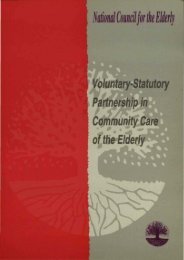Improving Quality of Life for Older People in Long-Stay Care ...
Improving Quality of Life for Older People in Long-Stay Care ...
Improving Quality of Life for Older People in Long-Stay Care ...
- No tags were found...
You also want an ePaper? Increase the reach of your titles
YUMPU automatically turns print PDFs into web optimized ePapers that Google loves.
from stakeholders who attended the focus groups. A total <strong>of</strong> 12 doma<strong>in</strong>s werepresented to residents: ethos <strong>of</strong> care; choice and control; privacy; feel<strong>in</strong>g cared<strong>for</strong>/feel<strong>in</strong>g secure; sense <strong>of</strong> self; mean<strong>in</strong>gful activity; companionship; relationships;cont<strong>in</strong>uity with life/community; <strong>in</strong>dependence; spirituality and a general category.All <strong>in</strong>terviews addressed the 12 doma<strong>in</strong>s but the schedule was used flexibly <strong>in</strong>order to allow a conversational <strong>in</strong>terview style. The schedule <strong>in</strong>cluded promptswhich were used only if resident participants required further guidance. Two pilot<strong>in</strong>terviews were undertaken <strong>in</strong> order to test the <strong>in</strong>terview schedules. Follow<strong>in</strong>ganalysis <strong>of</strong> the pilot data, some m<strong>in</strong>or modifications to the schedules were made.A similar schedule was prepared <strong>for</strong> staff (Appendix Four) and relatives (AppendixFive). In the staff <strong>in</strong>terview schedule specific questions on resident quality <strong>of</strong> lifeand staff educational needs were added.4.5.7 Sampl<strong>in</strong>g StrategyA purposive sampl<strong>in</strong>g strategy was employed which is typical <strong>of</strong> qualitativeresearch. Purposive sampl<strong>in</strong>g entails mak<strong>in</strong>g a ‘calculated decision to sample aspecific locale accord<strong>in</strong>g to a preconceived but reasonable <strong>in</strong>itial set <strong>of</strong> dimensions’(Cutcliffe, 2000). In this study the follow<strong>in</strong>g sampl<strong>in</strong>g decisions were taken:91to sample across the five care facility types, <strong>in</strong>clud<strong>in</strong>g rural and urban sett<strong>in</strong>gsto ensure the views <strong>of</strong> both men and women were representedto <strong>in</strong>clude residents who were new to the facility (there <strong>for</strong> less thanthree months) and those who had resided <strong>in</strong> the facility <strong>for</strong> longer periodsto <strong>in</strong>clude residents who had significant communication difficultiesto <strong>in</strong>clude staff with different roles, <strong>for</strong> example cooks, physiotherapists,nurses and activity therapists; and at different levels, <strong>for</strong> example directors<strong>of</strong> nurs<strong>in</strong>g, registered nurses and care assistants.There are no firm criteria or rules regard<strong>in</strong>g sampl<strong>in</strong>g size <strong>in</strong> qualitative research.A small sample size permitt<strong>in</strong>g full, <strong>in</strong>-depth study <strong>of</strong> the chosen topic is typical<strong>of</strong> qualitative studies (Tuckett, 2004; Miles and Huberman, 1994; Patton, 1990).Factors such as the quality <strong>of</strong> <strong>in</strong><strong>for</strong>mation, type <strong>of</strong> <strong>in</strong>terview and available timemay determ<strong>in</strong>e what is possible (Polit and Beck, 2004). The goal <strong>in</strong> this study wasto <strong>in</strong>clude the perspectives <strong>of</strong> as many residents, staff and relatives as possible.A pragmatic decision was taken, there<strong>for</strong>e, to <strong>in</strong>terview as many residents aspossible with<strong>in</strong> the available time.















